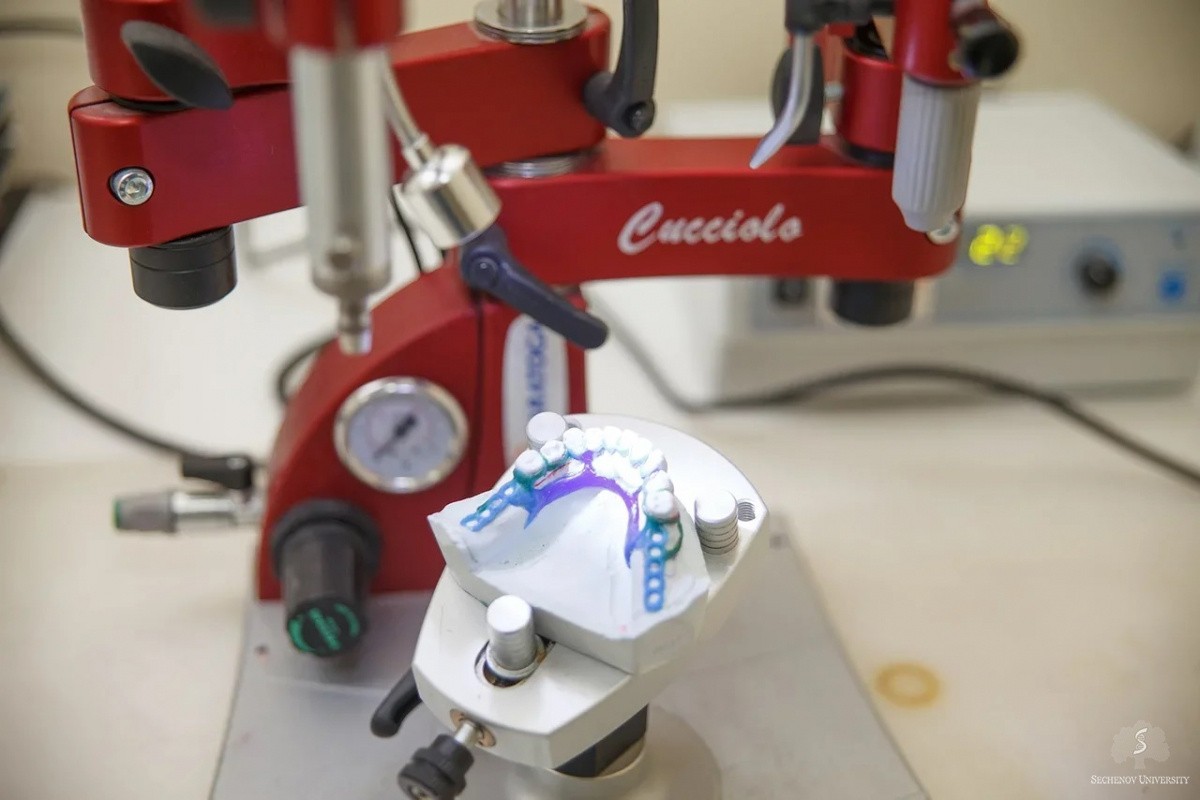-
About University
- Mission & Brand Strategy
- University Leadership
- Rector's Welcome
- History
- Regulatory Documents
- Contacts
- Staff
- International Recruitment
- Partners
Applicants- Why Sechenov University
- Degree Programmes in English
- Preparatory Courses
- Non-Degree Programmes
- Transfer from other Institutions
24.09.2020New component of toothpaste strengthens enamel
 Tooth hypersensitivity is a problem with a complex background. The enamel suffers from the food we eat, and it is necessary to restore it. Good oral hygiene is important, and toothpaste components can be crucial for this. Sechenov dentists performed a clinical study to analyse the effect of a novel component, brushite, and found that it had good remineralising properties.
Tooth hypersensitivity is a problem with a complex background. The enamel suffers from the food we eat, and it is necessary to restore it. Good oral hygiene is important, and toothpaste components can be crucial for this. Sechenov dentists performed a clinical study to analyse the effect of a novel component, brushite, and found that it had good remineralising properties.
The resistance of tooth enamel to aggressive chemical media is a very important question that determines the health of our teeth to a great extent. The enamel contains minerals which prevent the tooth from hypersensitivity. Demineralisation can happen because of the organic acids produced by microorganisms in the mouth, for example, during sugar degradation. Certain kinds of toothpaste are able to remineralise the enamel, and usually, they contain calcium, phosphate, and fluoride. Contemporary dentistry can offer new remineralising components, such as hydroxyapatite or brushite. Scientists from Sechenov University have performed a clinical study to test the effect of different kinds of toothpaste with novel compounds and ruled out that remineralisation can be achieved. The results have been published in the Journal of International Society of Preventive and Community Dentistry.
The researchers assessed the new type of toothpaste which promotes the formation of brushite. It is a mineral with the formula CaHPO4•2H2O which serves as a precursor to hydroxyapatite Ca5(PO4)3OH. Both compounds contain calcium and phosphate — key ingredients already known for filling the defects in mineralised tissues.
The randomised, double-blind, controlled study involved 60 volunteers aged 20–25 with enamel hypersensitivity, who were otherwise healthy. The participants were separated into 3 groups of 20 people. Group 1 was told to use brushite-forming toothpaste (test group); Group 2 was given toothpaste with hydroxyapatite (positive control group); Group 3 used toothpaste without fluoride and hydroxyapatite (negative control group). The experiment took one month to complete, and the volunteers underwent examinations at the start, after 2 weeks, and after 4 weeks. At each time point, the simplified oral hygiene index (OHI-S) was assessed, the acid resistance of the enamel was tested, the rate of enamel remineralisation was evaluated, and the Schiff test was performed to evaluate the tooth sensitivity.
Those who used the toothpaste with hydroxyapatite and brushite-forming components (positive control and test groups) had much better enamel resistance to acid and a higher speed of remineralisation. However, hydroxyapatite toothpaste caused these effects earlier — after 2 weeks of the clinical study. Considerable reduction in the sensitivity was observed after 2 weeks in both groups, compared to the negative control group.
The study included only young subjects, and it could be its limitation: older patients might experience a lesser effect of the special toothpaste due to the changes in enamel mineralisation and structure.
The authors conclude that, to the best of their knowledge, brushite effectiveness has not been assessed in a clinical study before. The results suggest that the effects of the toothpaste with hydroxyapatite and brushite-forming components are very close.
‘Hydroxyapatite is a trend in prophylaxis and treatment of dental hyperesthesia’, said Ksenia Babina, Associate Professor at the Department of Therapeutic Dentistry (Sechenov University) and one of the authors of the study. ‘Because of this, a lot of research is being done to develop the hydroxyapatite form: size, particle shape, or combination with different ions. In our study, we have shown that brushite — which is structurally similar to hydroxyapatite — has a comparable effectivity in the treatment of tooth hypersensitivity, and it may be used as a cheaper yet good alternative to hydroxyapatite’.
The study was carried out by the Department of Therapeutic Dentistry (Sechenov University) with the support of the Russian Academic Excellence Project ‘5–100’.
Read more: Polyakova MA, Arakelyan MG, Babina KS, et al. Qualitative and Quantitative Assessment of Remineralizing Effect of Prophylactic Toothpaste Promoting Brushite Formation: A Randomized Clinical Trial. J Int Soc Prev Community Dent (2020).
Embed on website
New component of toothpaste strengthens enamel
Tooth hypersensitivity is a problem with a complex background. The enamel suffers from the food we eat, and it is necessary to restore it. Good oral hygiene is important, and toothpaste components can be crucial for this. Sechenov dentists performed a clinical study to analyse the effect of a novel component, brushite, and found that it had good remineralising properties.
The resistance of tooth enamel to aggressive chemical media is a very important question that determines the health of our teeth to a great extent. The enamel contains minerals which prevent the tooth from hypersensitivity. Demineralisation can happen because of the organic acids produced by microorganisms in the mouth, for example, during sugar degradation. Certain kinds of toothpaste are able to remineralise the enamel, and usually, they contain calcium, phosphate, and fluoride. Contemporary dentistry can offer new remineralising components, such as hydroxyapatite or brushite. Scientists from Sechenov University have performed a clinical study to test the effect of different kinds of toothpaste with novel compounds and ruled out that remineralisation can be achieved. The results have been published in the Journal of International Society of Preventive and Community Dentistry.
The researchers assessed the new type of toothpaste which promotes the formation of brushite. It is a mineral with the formula CaHPO4•2H2O which serves as a precursor to hydroxyapatite Ca5(PO4)3OH. Both compounds contain calcium and phosphate — key ingredients already known for filling the defects in mineralised tissues.
The randomised, double-blind, controlled study involved 60 volunteers aged 20–25 with enamel hypersensitivity, who were otherwise healthy. The participants were separated into 3 groups of 20 people. Group 1 was told to use brushite-forming toothpaste (test group); Group 2 was given toothpaste with hydroxyapatite (positive control group); Group 3 used toothpaste without fluoride and hydroxyapatite (negative control group). The experiment took one month to complete, and the volunteers underwent examinations at the start, after 2 weeks, and after 4 weeks. At each time point, the simplified oral hygiene index (OHI-S) was assessed, the acid resistance of the enamel was tested, the rate of enamel remineralisation was evaluated, and the Schiff test was performed to evaluate the tooth sensitivity.
Those who used the toothpaste with hydroxyapatite and brushite-forming components (positive control and test groups) had much better enamel resistance to acid and a higher speed of remineralisation. However, hydroxyapatite toothpaste caused these effects earlier — after 2 weeks of the clinical study. Considerable reduction in the sensitivity was observed after 2 weeks in both groups, compared to the negative control group.
The study included only young subjects, and it could be its limitation: older patients might experience a lesser effect of the special toothpaste due to the changes in enamel mineralisation and structure.
The authors conclude that, to the best of their knowledge, brushite effectiveness has not been assessed in a clinical study before. The results suggest that the effects of the toothpaste with hydroxyapatite and brushite-forming components are very close.
‘Hydroxyapatite is a trend in prophylaxis and treatment of dental hyperesthesia’, said Ksenia Babina, Associate Professor at the Department of Therapeutic Dentistry (Sechenov University) and one of the authors of the study. ‘Because of this, a lot of research is being done to develop the hydroxyapatite form: size, particle shape, or combination with different ions. In our study, we have shown that brushite — which is structurally similar to hydroxyapatite — has a comparable effectivity in the treatment of tooth hypersensitivity, and it may be used as a cheaper yet good alternative to hydroxyapatite’.
The study was carried out by the Department of Therapeutic Dentistry (Sechenov University) with the support of the Russian Academic Excellence Project ‘5–100’.
Read more: Polyakova MA, Arakelyan MG, Babina KS, et al. Qualitative and Quantitative Assessment of Remineralizing Effect of Prophylactic Toothpaste Promoting Brushite Formation: A Randomized Clinical Trial. J Int Soc Prev Community Dent (2020).



